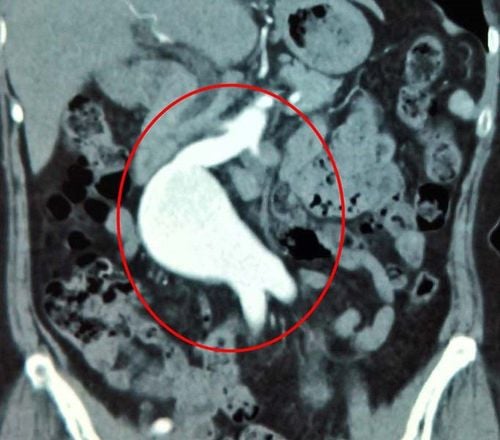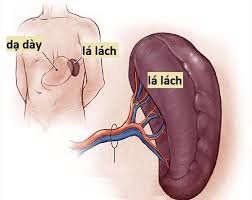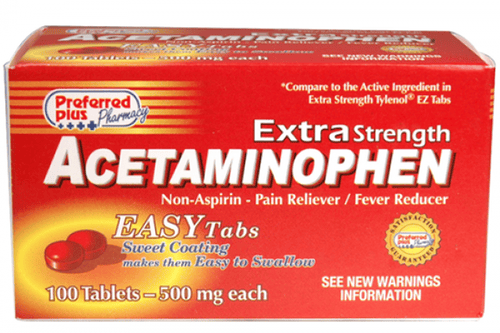This is an automatically translated article.
The article is professionally consulted by Master, Doctor Do Xuan Chien and Master, Doctor Hoang Thi Hoa - Department of Medical Examination and Internal Medicine - Vinmec Ha Long International General Hospital.Abdominal aortic aneurysms are common in people over 60 years of age. Abdominal aortic aneurysms don't cause obvious symptoms, they grow slowly over many years, and if they grow quickly, they tear (rupture), or blood flows along the artery wall (aortic dissection). ), symptoms can come on suddenly.
1. What is an abdominal aortic aneurysm?
The aorta is the largest artery in the human body, carrying oxygen-rich blood to be pumped out of your heart or away from your heart. The aorta runs through your chest, where it's called the thoracic aorta. When the aorta travels to your abdomen, it is called the abdominal aorta. The abdominal aorta supplies blood to the lower body. In the abdomen, just below the navel, the aorta divides into two branches, called the iliac arteries, that carry blood to each leg.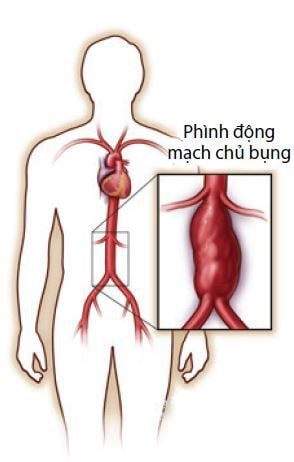
The cause of abdominal aortic aneurysm is multifactorial. Some of the main causes of abdominal aortic aneurysms include:
Hypertension Atherosclerosis: this is the most commonly diagnosed cause of abdominal aortic aneurysms. Some other causes are due to:
The patient has an infection in the aorta (vasculitis). In rare cases, an abdominal aortic aneurysm can be caused by infection or inflammation of a vasculature, which weakens part of the aortic wall. Connective tissue disease (such as Ehlers-Danlos syndrome).
Trắc nghiệm: Bạn có hiểu đúng về huyết áp cao không?
Huyết áp cao còn được gọi là kẻ giết người thầm lặng vì bệnh thường không có triệu chứng. Thiếu hụt kiến thức về huyết áp cao có thể làm cho tình trạng bệnh trở nên trầm trọng hơn. Dưới đây là những câu hỏi trắc nghiệm vui giúp bạn hiểu đúng về bệnh cao huyết áp.2. Who is at risk for abdominal aortic aneurysm?
Anyone can get an abdominal aortic aneurysm, but it is more common in people over 60 years of age. According to the World Health Organization (WHO), abdominal aortic aneurysms are more common in men than in women. You can limit your chances of getting the disease by minimizing your risk factors. Always consult your doctor for more information.Factors that increase your risk of developing an abdominal aortic aneurysm are:
Being 55 or 60 years old People who smoke, drink alcohol People with high blood pressure Having atherosclerosis : Due to the accumulation of fat and other substances that can damage blood vessel walls, increase the risk of abdominal aortic aneurysm Patients with abdominal aortic aneurysm have a relative who also has the disease Male: Statistics show that men are 6 times more likely to have an abdominal aortic aneurysm than women.
3. Signs of abdominal aortic aneurysm

Some signs of abdominal aortic aneurysm may be encountered such as:
Abdominal pain, pain usually localized in the hypogastrium or the back. The pain is often constant, excruciating and lasts for hours to days. In contrast to musculoskeletal pain in the back, movement does not affect the sensation of aneurysm pain, although in certain positions the patient may also feel more comfortable.
The onset of new or increased pain comes on suddenly and may herald further dilatation or the threat of rupture of the aneurysm. The pain is characterized by constant, intense pain that is localized to your back or lower abdomen. The pain can radiate down the groin area, into the hip area, or, in rare cases, down the leg. A ruptured abdominal aorta will actually be accompanied by a sudden onset of back pain along with abdominal pain and abdominal distension. Most patients have a mass, palpable in the abdomen, and pulsating heart rate accompanied by a drop in blood pressure that is considered characteristic of an abdominal aortic aneurysm.
Abdominal aortic aneurysm has signs of threatened rupture, the patient has sudden severe abdominal pain, similar to other acute abdominal conditions such as renal colic, appendicitis, or gastric bleeding - bowels, this is a life-threatening situation and you should go to the emergency room immediately.
4. Prevention and control of abdominal aortic aneurysm
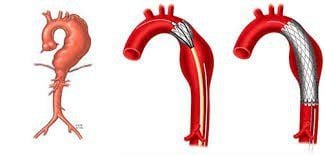
Some risk factors, such as age and genetics, cannot be controlled. However, other risk factors can be adjusted or controlled, which greatly reduces your chances of developing abdominal and other aortic aneurysms.
Some things you can do to reduce your risk include:
Don't smoke, drink alcohol: Smoking, drinking alcohol is a major risk factor for all vascular diseases, including including abdominal aortic aneurysm Blood pressure control : High blood pressure is an important cause of vascular disease, you should maintain normal blood pressure by using a reasonable diet, controlling stress Stress, or taking medication to control blood pressure will reduce your chances of developing an abdominal aortic aneurysm in particular. Control your cholesterol levels: high cholesterol leads to atherosclerosis - which is one of the leading causes of aneuryss. main artery. Keep your cholesterol under control by eating a healthy diet and exercising to maintain a healthy weight. Regular physical examination: The European Society of Cardiology (ESC) recommends ultrasound screening for abdominal aortic aneurysm. with all men over 65 years of age (strong evidence level IA), or women over 65 years of age with a history of smoking (weaker evidence level IIb) so that your doctor can find out that you may be at risk. muscle has an aortic aneurysm and you may need screening tests. In addition, when you maintain regular checkups, problems that can increase your risk of aortic aneurysms, such as high blood pressure and high cholesterol, can be detected and treated early. If you have signs of abdominal aortic aneurysm, you should go to specialized medical facilities to be examined and consult a doctor for advice on the best supportive treatment methods.
Vinmec International General Hospital is the leading medical address for diagnosis and treatment of aortic aneurysms. It has all the necessary medical equipment to perform simple to complex treatments such as medical treatment, stent-graft intervention, surgery... highly qualified, trained and certified technical, can handle quickly and effectively, especially in cases of urgent emergency. Therefore, patients with thoracic aortic aneurysms can rest assured with a strict, methodical and effective treatment process at Vinmec.
Please dial HOTLINE for more information or register for an appointment HERE. Download MyVinmec app to make appointments faster and to manage your bookings easily.





